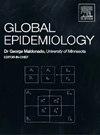Body mass index and mortality in a nationally representative cohort of south African adults
引用次数: 0
Abstract
Aim
To examine the association between Body Mass Index (BMI) and all-cause mortality in South Africa.
Methods
Longitudinal data on adults 20 years and older from five waves (2008, 2010–11, 2012, 2014–15, and 2017) of the South African National Income Dynamics Study were analysed. Survival proportional hazard models, adjusted for sociodemographic and lifestyle characteristics, were used to estimate the relationship between BMI and mortality. Sensitivity analyses were conducted to assess the robustness of the estimates.
Results
Of the 12,402 eligible individuals, 10917 had valid BMI measurements and were included in the analyses. During a total of 83,077 person-years of observation, 1741 individuals died.
Hazard ratios for all-cause mortality were significantly lower in the BMI range 25–40 kg/m2 in comparison with the reference category of 18.5–25 kg/m2 and were minimal in the range 30–35 kg/m2 (HR = 0.68, 95% CI: 0.50–0.88). BMI < 18.5 kg/m2 was associated with an increased risk of death, with a maximum hazard ratio of 2.14 (95% CI: 1.36–3.4) in the <16 kg/m2 category. The pattern was repeated in the sex-specific analyses. The relationship persisted after restricting the analyses to never smokers, excluding subjects with pre-existing conditions or who died in the first two years of follow-up.
Conclusions
This study suggests that, in the South African adult population, BMI in the overweight or mild obesity range according to international definitions is associated with a reduced risk of mortality compared to the” healthy weight” range. Further research is needed to corroborate these results.
一项具有全国代表性的南非成年人队列的体重指数和死亡率
目的探讨南非人身体质量指数(BMI)与全因死亡率之间的关系。方法对南非国民收入动态研究五波(2008年、2010-11年、2012年、2014-15年和2017年)20岁及以上成年人的纵向数据进行分析。经社会人口统计学和生活方式特征调整后的生存比例风险模型用于估计BMI和死亡率之间的关系。进行敏感性分析以评估估计的稳健性。结果在12402名符合条件的个体中,10917名具有有效的BMI测量值,并被纳入分析。在总共83077人年的观察中,1741人死亡。与参考类别18.5-25 kg/m2相比,BMI在25-40 kg/m2范围内的全因死亡率风险比显著降低,而在30-35 kg/m2范围内的全因死亡率风险比最小(HR = 0.68, 95% CI: 0.50-0.88)。BMI 18.5 kg/m2与死亡风险增加相关,在16 kg/m2类别中,最大风险比为2.14 (95% CI: 1.36-3.4)。在性别分析中重复了这种模式。在将分析对象限制为从不吸烟者,排除了已有疾病或在随访前两年死亡的受试者后,这种关系仍然存在。结论:本研究表明,在南非成年人中,根据国际定义,BMI处于超重或轻度肥胖范围内,与“健康体重”范围相比,死亡率风险降低。需要进一步的研究来证实这些结果。
本文章由计算机程序翻译,如有差异,请以英文原文为准。
求助全文
约1分钟内获得全文
求助全文

 求助内容:
求助内容: 应助结果提醒方式:
应助结果提醒方式:


